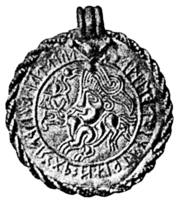
Vadstena bracteate
Encyclopedia

Gold
Gold is a chemical element with the symbol Au and an atomic number of 79. Gold is a dense, soft, shiny, malleable and ductile metal. Pure gold has a bright yellow color and luster traditionally considered attractive, which it maintains without oxidizing in air or water. Chemically, gold is a...
C-bracteate
Bracteate
A bracteate is a flat, thin, single-sided gold medal worn as jewelry that was produced in Northern Europe predominantly during the Migration Period of the Germanic Iron Age...
found in the earth at Vadstena
Vadstena
Vadstena is a locality and the seat of Vadstena Municipality, Östergötland County, Sweden, with 5,612 inhabitants in 2005. From 1974 to 1979 Vadstena was administered as part of Motala Municipality....
, Sweden
Sweden
Sweden , officially the Kingdom of Sweden , is a Nordic country on the Scandinavian Peninsula in Northern Europe. Sweden borders with Norway and Finland and is connected to Denmark by a bridge-tunnel across the Öresund....
, in 1774. Along with the bracteate was a gold ring and a piece of gold sheet: all were about melted down by a goldsmith
Goldsmith
A goldsmith is a metalworker who specializes in working with gold and other precious metals. Since ancient times the techniques of a goldsmith have evolved very little in order to produce items of jewelry of quality standards. In modern times actual goldsmiths are rare...
who was stopped by a local clergyman. The bracteate was stolen in 1938 from the Swedish Museum of National Antiquities
Swedish Museum of National Antiquities
Swedish Museum of National Antiquities is a museum located in Stockholm, Sweden that covers Swedish cultural history and art from the Stone Age to the 16th century...
and has not yet been found.
The bracteate is believed to have been made about AD 500. In the middle of the bracteate is a four-legged animal with a man's head above it, and in front of this a bird separated from the other image by a line. (The image is commonly associated with Odin
Odin
Odin is a major god in Norse mythology and the ruler of Asgard. Homologous with the Anglo-Saxon "Wōden" and the Old High German "Wotan", the name is descended from Proto-Germanic "*Wodanaz" or "*Wōđanaz"....
in bracteate iconography
Iconography
Iconography is the branch of art history which studies the identification, description, and the interpretation of the content of images. The word iconography literally means "image writing", and comes from the Greek "image" and "to write". A secondary meaning is the painting of icons in the...
) The bracteate is most famous for containing a full listing of the Elder Futhark
Elder Futhark
The Elder Futhark is the oldest form of the runic alphabet, used by Germanic tribes for Northwest Germanic and Migration period Germanic dialects of the 2nd to 8th centuries for inscriptions on artifacts such as jewellery, amulets, tools, weapons and runestones...
Runic alphabet
Runic alphabet
The runic alphabets are a set of related alphabets using letters known as runes to write various Germanic languages before the adoption of the Latin alphabet and for specialized purposes thereafter...
. The entire inscription reads:
- tuwatuwa; fuþarkgw; hnijïpzs; tbemlŋo[d]
The last rune (d) is hidden below the necklace holder piece that has been molded on top of the bracteate, but archaeologists know what it is because a duplicate bracteate was found in Motala
Motala
Motala is a locality and the seat of Motala Municipality, Östergötland County, Sweden with 29,798 inhabitants in 2005. It is the third largest city of Östergötland, following Linköping and Norrköping...
(image) which read:
- (t)uwatuwa; fuþarkgw; hnijïpzs; tbemlŋod.
The first part of the inscriptions is not yet understood but is assumed to be associated with magic, this is however a common stock-explanation to runes not yet deciphered.
The Motala
Motala
Motala is a locality and the seat of Motala Municipality, Östergötland County, Sweden with 29,798 inhabitants in 2005. It is the third largest city of Östergötland, following Linköping and Norrköping...
bracteate has been struck with the same die and was found at a nearby town in the same province, Östergötland
Östergötland
Östergötland, English exonym: East Gothland, is one of the traditional provinces of Sweden in the south of Sweden. It borders Småland, Västergötland, Närke, Södermanland, and the Baltic Sea. In older English literature, one might also encounter the Latinized version, Ostrogothia...
, in 1906. When it reached the Swedish Museum of National Antiquities
Swedish Museum of National Antiquities
Swedish Museum of National Antiquities is a museum located in Stockholm, Sweden that covers Swedish cultural history and art from the Stone Age to the 16th century...
, however, it was erroneously catalogued as deriving from Mariedamm in the adjoining province Närke
Närke
' is a Swedish traditional province, or landskap, situated in Svealand in south central Sweden. It is bordered by Västmanland to the north, Södermanland to the east, Östergötland to the southeast, Västergötland to the southwest, and Värmland to the northwest...
(Nä 10). This misattribution lives on sporadically in the literature. Another persistent misconception regarding the Vadstena bracteate (probably also inspired by the 1906 find) is that two identical bracteates have been found in that town, bringing the total number of copies to three.

